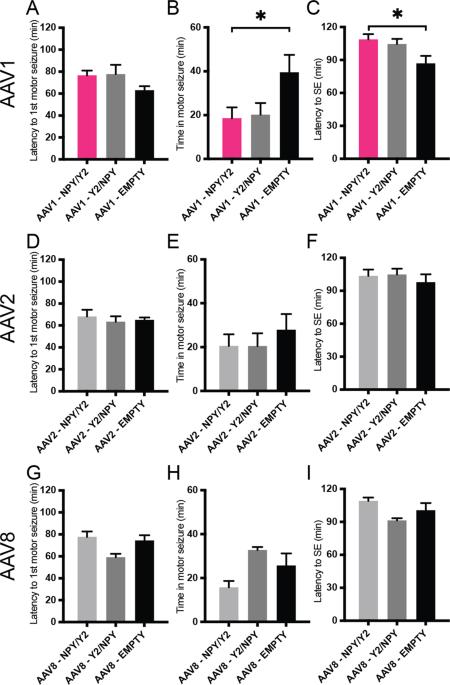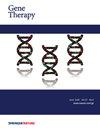癫痫的组合基因疗法:基因序列定位和 AAV 血清型影响表达和对癫痫发作的抑制作用
IF 4.6
3区 医学
Q1 BIOCHEMISTRY & MOLECULAR BIOLOGY
引用次数: 0
摘要
使用携带神经肽 Y 及其受体 Y2 基因的 AAV 载体进行基因治疗,已在多种癫痫动物模型中证实可抑制癫痫发作。然而,目前还不清楚 AAV 血清型或表达盒中这两个转基因的序列顺序如何影响实质基因的实际表达水平和癫痫抑制效果。为了解决这些问题,我们在急性诱导癫痫发作大鼠模型中比较了三种病毒载体血清型(AAV1、AAV2 和 AAV8)和两种转基因序列顺序(NPY-IRES-Y2 和 Y2-IRES-NPY)。雄性 Wistar 大鼠双侧注射病毒载体,3 周后通过皮下注射凯因特诱导急性癫痫发作。与空盒式对照载体相比,测量了这些载体抑制癫痫发作的效果,包括首次运动性癫痫发作的潜伏期、运动性癫痫发作的持续时间和癫痫状态的潜伏期。在此基础上,通过体外电生理学进一步研究了AAV1-NPY-IRES-Y2载体的效果,并评估了其在切除的人类海马组织中实现转基因过表达的能力。事实证明,AAV1-NPY-IRES-Y2 在转基因表达和抑制大鼠癫痫发作的能力方面都优于其他任何血清型或基因序列。该载体还证明了转基因诱导的兴奋性神经元终端谷氨酸释放减少,并显著增加了耐药性颞叶癫痫患者切除的人类海马组织中 NPY 和 Y2 的表达。这些结果验证了 NPY/Y2 受体基因疗法作为局灶性癫痫治疗方法的可行性。本文章由计算机程序翻译,如有差异,请以英文原文为准。

Combinatorial gene therapy for epilepsy: Gene sequence positioning and AAV serotype influence expression and inhibitory effect on seizures
Gene therapy with AAV vectors carrying genes for neuropeptide Y and its receptor Y2 has been shown to inhibit seizures in multiple animal models of epilepsy. It is however unknown how the AAV serotype or the sequence order of these two transgenes in the expression cassette affects the actual parenchymal gene expression levels and the seizure-suppressant efficacy. To address these questions, we compared three viral vector serotypes (AAV1, AAV2 and AAV8) and two transgene sequence orders (NPY-IRES-Y2 and Y2-IRES-NPY) in a rat model of acutely induced seizures. Wistar male rats were injected bilaterally with viral vectors and 3 weeks later acute seizures were induced by a subcutaneous injection of kainate. The latency until 1st motor seizure, time spent in motor seizure and latency to status epilepticus were measured to evaluate the seizure-suppressing efficacy of these vectors compared to an empty cassette control vector. Based on the results, the effect of the AAV1-NPY-IRES-Y2 vector was further investigated by in vitro electrophysiology, and its ability to achieve transgene overexpression in resected human hippocampal tissue was evaluated. The AAV1-NPY-IRES-Y2 proved to be better to any other serotype or gene sequence considering both transgene expression and ability to suppress induced seizures in rats. The vector also demonstrated transgene-induced decrease of glutamate release from excitatory neuron terminals and significantly increased both NPY and Y2 expression in resected human hippocampal tissue from patients with drug-resistant temporal lobe epilepsy. These results validate the feasibility of NPY/Y2 receptor gene therapy as a therapeutic opportunity in focal epilepsies.
求助全文
通过发布文献求助,成功后即可免费获取论文全文。
去求助
来源期刊

Gene Therapy
医学-生化与分子生物学
CiteScore
9.70
自引率
2.00%
发文量
67
审稿时长
4-8 weeks
期刊介绍:
Gene Therapy covers both the research and clinical applications of novel therapeutic techniques based on a genetic component. Over the last few decades, significant advances in technologies ranging from identifying novel genetic targets that cause disease through to clinical studies, which show therapeutic benefit, have elevated this multidisciplinary field to the forefront of modern medicine.
 求助内容:
求助内容: 应助结果提醒方式:
应助结果提醒方式:


